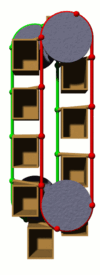Paternoster Lifts
 I was reminded of these lifts the other day and it brought up dim memories from the past. Some few year ago I attended the University of Salford and the now demolished tower block housed a paternoster lift. For those not familiar the illustration shows how they work.
I was reminded of these lifts the other day and it brought up dim memories from the past. Some few year ago I attended the University of Salford and the now demolished tower block housed a paternoster lift. For those not familiar the illustration shows how they work.
These lifts were first built in 1884 by J. E. Hall and called a paternoster ("Our Father", the first two words of the Lord's Prayer in Latin) due to its resemblance of a loop of rosary beads. The are not built anymore, apparently due to safety concerns (have to say I was always slightly worried about somehow becoming squashed).
To use these lifts you just walk on when it passes your floor and walk off at your destination floor. At Salford I think there was some rule about no more than two people in a pod and something about not going over the top (up and over). Of course in a student building may as well have not had any rules and Iremember up and over journeys being used as a reason for frequent stoppages (apparently the lift became unbalanced - or so we were told).
There are a few surviving lifts in operation in various places. Wikipedia has a list of some of these, just in case you are in the vicinity and want to try one out the list can be found here http://en.wikipedia.org/wiki/Paternoster.